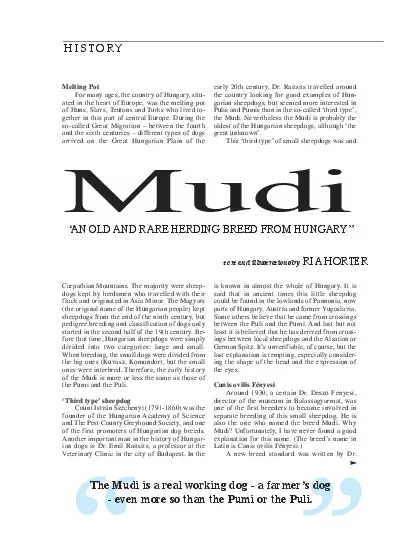

HISTORYThe Mudi is a real working dog a farmers dog even more so than the Pumi or the PuliRIA HRTERAN OLD AND RARE HERDING BREED FROM HUNGARYMudiHorter225240 61610 810 AM Page 1Zoltan Balass ID: 858050
Download Pdf The PPT/PDF document "For many ages the country of Hungary sit..." is the property of its rightful owner. Permission is granted to download and print the materials on this web site for personal, non-commercial use only, and to display it on your personal computer provided you do not modify the materials and that you retain all copyright notices contained in the materials. By downloading content from our website, you accept the terms of this agreement.
1 For many ages, the country of Hungary, s
For many ages, the country of Hungary, situ-of Huns, Slavs, Teutons and Turks who lived to-and the sixth centuries different types of dogsCarpathian Mountains. The majority were sheep-flock and originated in Asia Minor. The Magyarssheepdogs from the end of the ninth century, butstarted in the second half of the 19th century. Be-divided into two categories: large and small. HISTORY The Mudi is a real working dog - a farmers dog - even more so than the Pumi or the Puli. RIA HÖRTERAN OLD AND RARE HERDING BREED FROM HUNGARY Mudi_Horter:225-240 6/16/10 8:10 AM Page 1 Zoltan Balassy in 1966 to apply for FCI recognition. Thisstandard was based on only a handful of Mudis and themain differences between the original standard were ac- The F.C.I. approved the breed standard in 1966, butstill the case today. A new standard was written in 2000 andare many different types in the Mudi;they form a heterogeneous company,the Croatian sheepdog in body. a farmers dog - even more so than thePumi or the Puli. Today, most of themoften the litters are not registered. Thevermin. He is an expert with difficultand Finland. There are about 70 Mudisin The Nether-
2 lands, and world-A Curly-coateddifferenc
lands, and world-A Curly-coateddifferences. Firstand set obliquely, while the eyes of the Puli and Pumi areroundish. His ears are pricked, like those of a Spitz. Thecoat is not corded like the Pulis, but short or half-long andcurly. Sometimes Mudis are born without a tail, or with arescue dogs, for agility, and driving sheep. In Hungary, these dogs are organized in the HungarianPuli-Pumi-Mudi Club. A second breed club is named after HISTORYcontinued from page 230 A Hungarian gulyas, herdsman, drawn by Joseph Kiss. In general, the Mudi gives the impression of a curly-coated small Spitz.The Mudi is a real working dog a farmersdog even more so than the Pumi and the Puli.Photo by Tamár-Geng Katalin Mudi_Horter:225-240 6/16/10 8:10 AM Page 2 Today there are several breed clubs outside Hungary,Canada. The Mudi Club of America was founded in 2004Hungarian Breed Club - www.magyarmudiklub.freeweb.huWebring Mudis - www.mudi.hu Mudi Club of America www.mudi.us Mudi Association of Canada www.mudi.ca FCI breed standard www.fci.beHISTORY Very few people were involved in breeding and this is still the case today. Photo by Tamár-Geng Kat
3 alinAs there were 80 years ago, there ar
alinAs there were 80 years ago, there are many different types in the Mudi. to work. The body is almost square, rather light in build, butmuscled and solid. The head is wedge-shaped, taping towardthe nose, and has very little stop. The pointed ears are a re-verse V-shape and carried erect. Pendulous ears and an in-complete set of teeth are disqualifying faults. The ears canbe used independently of each other, like radar. Eyes aresion. The back is strong and short and slightly sloping to-ward the croup. His underline is slightly tucked-up. The ribsbody. Front feet and hind feet are round with well-knit toes. In Hungary, the tail is sometimes docked, but accordingto the breed standard this is undesirable. The head and frontlimbs are covered by short, straight and smooth hair. Onother parts of the body, the coat is very wavy or slightlygrey primary color, ash color and brown. A small white patchon the chest and small white markings on the toes are toler-overly shy, missing teeth, yellow eyes in black dogs, dropears, albinism, wolf grey colour, black and tan with yellowHeight/Weight:continued from page 232 Mudi_Horter:225-240 6/16/10 8:10 AM Page